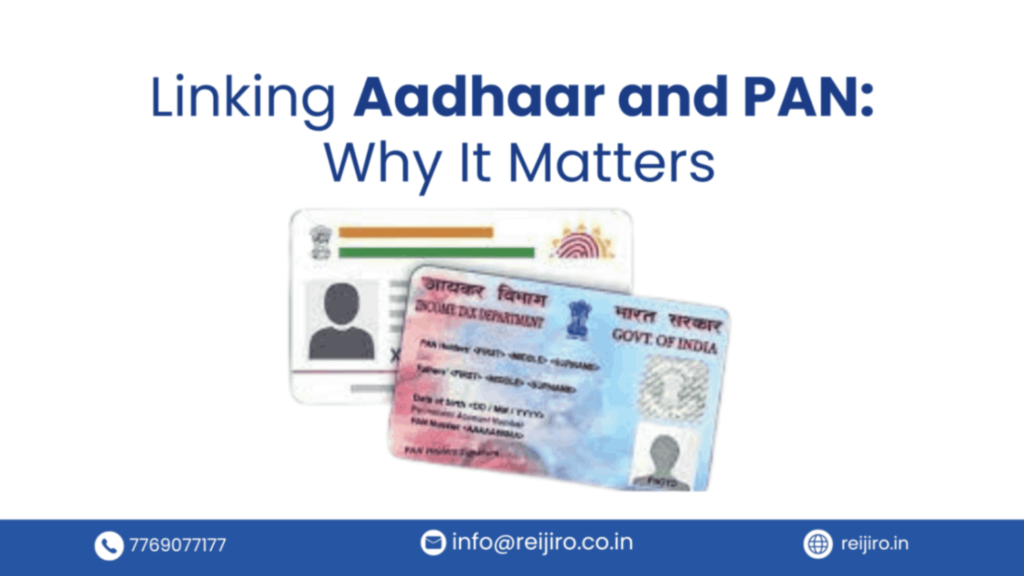Linking Aadhaar and PAN: Why It Matters
In the digital era, where technological advancements are transforming the way we conduct financial transactions and manage our identities, the linking of Aadhaar and PAN has emerged as a significant and mandatory process. This extensive blog aims to unravel the importance of connecting Aadhaar (the 12-digit unique identification number) with PAN (Permanent Account Number) in India. From understanding the basics to exploring the implications on taxation, financial transactions, and government initiatives, let’s dive into the comprehensive landscape of why linking Aadhaar and PAN truly matters.
Understanding Aadhaar and PAN
Aadhaar:
Aadhaar, issued by the Unique Identification Authority of India (UIDAI), is a unique 12-digit identification number assigned to residents of India. It serves as a digital identity that can be verified anytime, anywhere.
PAN:
Permanent Account Number (PAN) is a unique 10-character alphanumeric identifier issued by the Income Tax Department in India. It is a vital document for financial transactions and is often required for various purposes, including filing income tax returns.
Why Linking Aadhaar and PAN Matters
Streamlining Financial Identity:
Linking Aadhaar and PAN streamlines an individual’s financial identity. It ensures that the same person is associated with both identification numbers, reducing the risk of identity fraud and making financial transactions more secure.
Preventing Multiple PANs:
The linkage process helps prevent individuals from holding multiple PANs, which could lead to tax evasion and fraudulent financial activities. It promotes a cleaner and more accurate database of taxpayers.
Ease of Tax Compliance:
Linking Aadhaar and PAN facilitates ease of tax compliance. When filing income tax returns, having both identification numbers linked ensures seamless verification and reduces the likelihood of errors or discrepancies.
Curbing Tax Evasion:
The linkage is a crucial tool in the government’s efforts to curb tax evasion. It allows authorities to cross-verify financial information, making it more challenging for individuals to underreport income or engage in tax evasion.
Access to Government Services:
The linkage of Aadhaar and PAN is often a prerequisite for availing various government services and subsidies. It ensures that individuals receive their entitled benefits without the risk of duplication or fraud.
Facilitating PAN Application:
Linking Aadhaar with PAN has become mandatory for individuals applying for a new PAN card. It simplifies the application process and enhances the accuracy of information provided by applicants.
How to Link Aadhaar and PAN
Online Method:
- Visit the official e-filing website of the Income Tax Department (https://www.incometaxindiaefiling.gov.in/).
- Click on the “Link Aadhaar” option.
- Provide the necessary details, including PAN, Aadhaar number, and name as per Aadhaar.
- Enter the captcha code and click on the “Link Aadhaar” button.
- The linkage status will be displayed once the verification is successful.
SMS Method:
- Send an SMS to 567678 or 56161 in the following format: UIDPAN
<12-digit Aadhaar number> <10-digit PAN>.
For example: UIDPAN 123456789012 ABCDE1234F - You will receive an SMS confirming the status of the linkage.
Offline Method:
- Visit a PAN service center or NSDL facilitation center.
- Fill out Form 49A for Indian citizens or Form 49AA for foreign citizens.
Provide the required documents, including a copy of Aadhaar and proof of identity and address. - Submit the form and documents to the center, and the linkage will be processed.
The Legal Landscape: Aadhaar Act and Supreme Court Verdict
Aadhaar Act:
The Aadhaar (Targeted Delivery of Financial and Other Subsidies, Benefits, and Services) Act, 2016, provides the legal framework for the use of Aadhaar as a means of identity verification. It establishes the UIDAI and outlines the permissible uses of Aadhaar.
Supreme Court Verdict:
The Supreme Court of India, in its landmark judgment in 2018, upheld the constitutional validity of Aadhaar with certain limitations. The court ruled that Aadhaar is not mandatory for various services, but it can be required for specific purposes, including filing income tax returns and linking with PAN.
Implications on Taxation and Financial Transactions
Income Tax Return (ITR) Filing:
Linking Aadhaar and PAN is mandatory for filing income tax returns. It simplifies the process, as individuals can e-verify their returns using Aadhaar authentication.
Tax Refunds:
The linkage ensures smoother processing of tax refunds. It enables the Income Tax Department to verify the authenticity of refund claims, reducing the likelihood of fraudulent refund requests.
Property Transactions:
Aadhaar and PAN linkage is often required for property transactions. It enhances transparency and helps prevent the use of fake identities in real estate dealings.
Bank Transactions:
Aadhaar-PAN linkage is crucial for high-value bank transactions. It ensures that individuals conducting significant financial transactions are accurately identified, contributing to the overall security of the banking system.
Investments:
Individuals are required to link Aadhaar and PAN for various investments, including mutual funds, stocks, and other financial instruments. It streamlines the process of reporting financial transactions to regulatory authorities.
Challenges and Concerns
Privacy Concerns:
Critics raise concerns about privacy issues associated with the centralized storage of biometric and demographic data linked to Aadhaar. The government has taken steps to address these concerns and enhance data protection.
Authentication Errors:
Some individuals may face authentication errors or discrepancies during the linkage process. Ensuring that the details provided match the records with UIDAI and the Income Tax Department is essential to avoid such issues.
Legal Challenges:
There have been legal challenges to the mandatory nature of Aadhaar-PAN linkage. However, the Supreme Court’s verdict in 2018 clarified the permissible uses of Aadhaar, including its mandatory linkage for specific purposes.
Looking Ahead: The Future of Aadhaar and PAN Integration
Digital Transformation:
The integration of Aadhaar and PAN is part of India’s larger digital transformation initiative. It aligns with the government’s efforts to create a digital ecosystem that enhances transparency and efficiency in various sectors.
Enhanced Security Measures:
The government continues to implement enhanced security measures to protect Aadhaar data. Measures such as Virtual ID (VID) and limited KYC have been introduced to address privacy concerns and provide users with more control over their Aadhaar information.
Wider Applicability:
Aadhaar-PAN linkage is expected to have wider applicability in the future, including for availing government services, subsidies, and benefits. This integration aims to create a unified and secure identification system.
Conclusion: Strengthening the Foundations of a Digital India
In the intricate web of India’s digital landscape, the linkage of Aadhaar and PAN stands as a foundational element. It is a crucial step towards creating a more secure, transparent, and efficient system for identity verification and financial transactions. While challenges and concerns exist, the government’s commitment to addressing these issues and enhancing data protection reflects a proactive approach to ensure the success of this integration.
As individuals navigate the process of linking Aadhaar and PAN, it’s essential to stay informed about the legal framework, authentication procedures, and the broader implications on taxation and financial dealings. The linkage not only aligns with the government’s vision of a Digital India but also plays a pivotal role in fortifying the foundations of a modern, technologically advanced nation.



